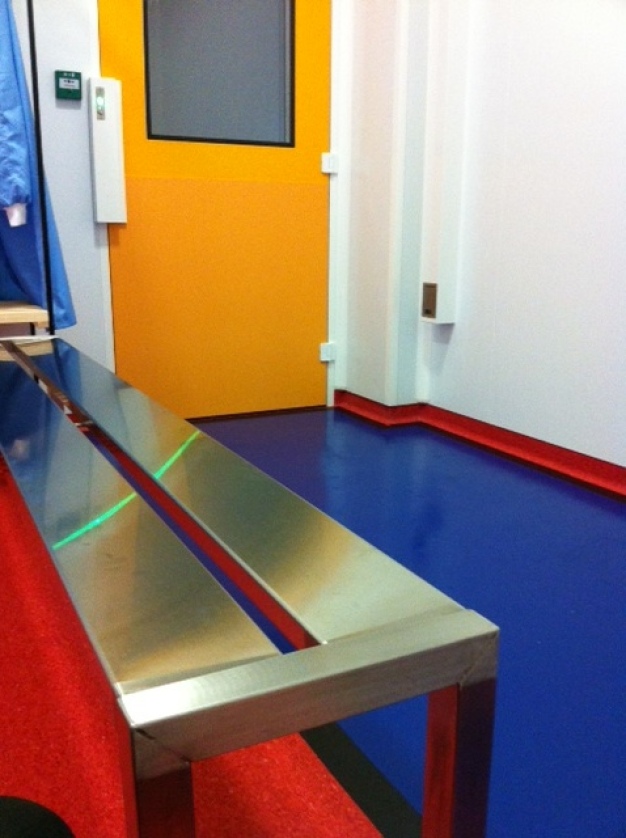Permanent tacky mats and flooring, for efficient contamination control
If left untreated, feet and wheels would be by far the biggest source of contamination in a cleanroom.
This is why the access to all gowning areas and cleanrooms should include a contamination control system specifically designed to trap footborne and wheelborne particles.
Two technologies are widely used by cleanroom managers to trap and retain this contamination : peel-off adhesive mats, and permanent tacky mats or flooring.
Both systems show some distinct advantages, calling for a differentiated use according to the situation.
Comparative benefits of peel-off mats with permanent mats
Whereas peel-off adhesive mats are the best option for retaining the bigger particles, permanent tacky mats and flooring are proven to be the most effective option on particles smaller than 5 microns. This calls for preferably placing peel-off mats close to the general / dirtier areas, and to install the permanent mats closer to the cleanroom.
Peel-off mats require no investment, and can be replaced at very little cost if damaged. But over time, they will add up to be a rather costly solution. On the contrary, permanent mats and flooring represent a bigger initial investment but cost very little throughout their lifetime. Over a 3 to 5 years course, which is the typical lifetime of a permanent mat, peel-off mats can cost up to 4 times more than permanent solutions.
Both systems require a regular care to make sure they keep their optimal efficacy. The top layer of peel-off mats has to be removed when it is visibly dirty : cleanroom operators themselves are often entrusted with this easy task, avoiding extra labor cost, but with the risk of an irregular maintenance. An inconvenient of peel-off mats is that they generate a high volume of waste ; according to the local legislation, this can represent a non-negligible hidden cost. On the contrary, permanent mats and flooring require a wet cleaning to retrieve their tacky properties. This operation is usually done by the cleaning crew, and is fully integrated in the general cleaning process of the cleanroom or gowning area.
For reasons of transport and storage, peel-off mats have rather small dimensions. The biggest ones commonly found measure no more than 1,5m in length and 1m in width. This is sometimes too small to correctly cover a high-traffic area, and leads cleanroom operators to stride across the mat without respecting the famous 3-step rule (each foot has to touch the mat 3 times). Permanent mats and flooring allow for a bigger coverage, thus improving the contamination control.
How do peel-off mats and permanent mats work?
Peel-off mats are made of successive layers of polyethylene sheets, each covered with glue. It relies on the adhesive properties of the glue to trap and retain the particles. Even is the glue is evenly spread, on a microscopic level the surface of a layer is quite rough, with peaks and valleys. It explains why peel-off mats are particularly efficient on bigger particles, while smaller particles could stay on the sole of a shoe or on a wheel if they are not in direct contact with one of the peaks. When a layer is visibly dirty, it is peeled off to reveal a new and clean layer.
Permanent mats and flooring rely on a completely different technology. They are made of a proprietary polymer whose main characteristic is to naturally have a slightly tacky surface. This tack is not due to the presence of glue, but to the exceptional flatness of the surface. Such flatness allow for particular physics phenomenons to occur : short-range electromagnetic forces, called van der Walls forces, bind small particles to the surface. Van der Walls forces are strong enough to retain the particles on the surface, despite air movements and further foot traffic. But they are weak enough to be broken by a traditional cleaning with a wet mop. This way, a simple wet cleaning is enough to restore the efficiency of the permanent mat or flooring.
What are the advantages of the b’mat permanent mats and flooring?
The b’mat flooring is intended to cover large areas, and is very often used for wall-to-wall covering. It requires an installation, and the permanent bond to the subfloor means that it can get the best of its very good load resistance, making it compatible with heavy lift- or hand-trucks.
The b’mat permanent mats are intended to cover smaller areas, up to 1,2m x 4m. In order to minimize the investment, and to maximize exploitation of available space, b’mat permanent mats are manufactured to custom dimensions and adapt to each configuration. They feature beveled edges on all 4 sides, and have a very small thickness of only 2,5mm, reducing the risk of tripping and meaning that they usually can fit under door openings.
All b’mat permanent mats and flooring demonstrate high contamination control results, bacteriostatic properties, good chemical resistance, and ESD properties. With a 2-year warranty and a usual lifetime of 3 to 5 years, b’mat is a very cost-effective and long-term contamination control solution for all cleanrooms.
![]()
VWR International GmbH
Hilpertstraße 20a
64295 Darmstadt
Germany
Phone: + 49 6151 39720
email: info.de@vwr.com
Internet: https://de.vwr.com









